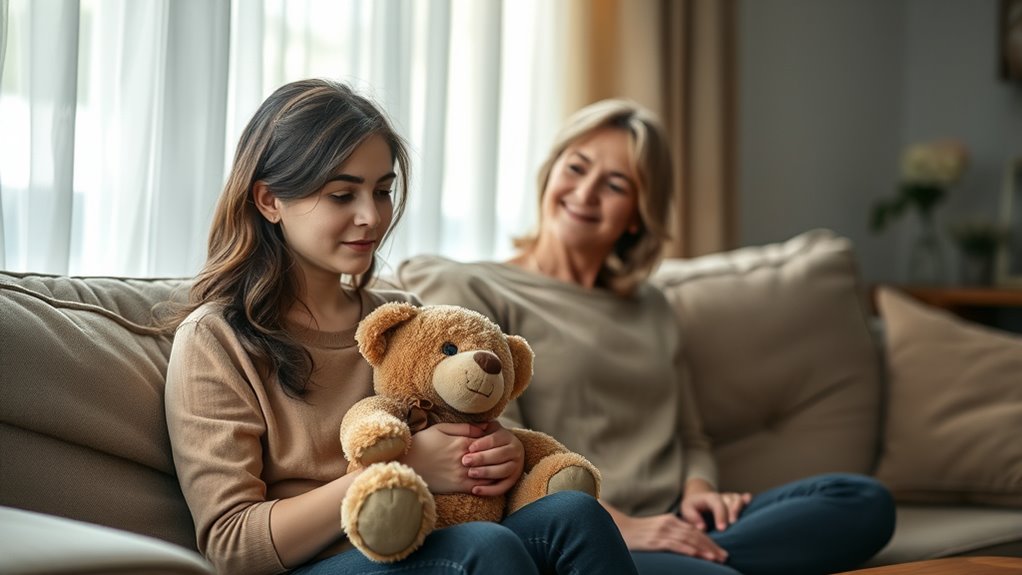Your attachment style shapes how you connect with others, especially in love. If you’re secure, you trust easily and communicate openly, leading to stable, satisfying relationships. If you’re insecure—like anxious or avoidant—you might struggle with trust, intimacy, or emotional closeness, which can create challenges and misunderstandings. Recognizing your bonding style helps you understand your behaviors and grow healthier connections. Keep exploring to discover how you can strengthen your relationships and build lasting trust.
Key Takeaways
- Your attachment style, formed in childhood, influences how you trust, communicate, and connect in romantic relationships.
- Secure attachment fosters healthy intimacy, trust, and stability, while insecure styles can cause fear, avoidance, or clinginess.
- Insecure attachment patterns may lead to relationship conflicts, emotional distance, or difficulty with vulnerability and trust.
- Recognizing your attachment style helps improve relationship satisfaction and supports healing for healthier bonds.
- Intergenerational patterns suggest that attachment behaviors can be inherited and improved through awareness and therapy.
Understanding the Four Main Attachment Styles

Understanding the four main attachment styles helps you recognize how early relationships shape your adult behaviors and emotions. You might identify as secure if you feel comfortable with intimacy, trust others easily, and communicate openly. If you often worry about your partner’s love or fear abandonment, you may have an anxious attachment. Avoidant types tend to keep emotional distance and prioritize independence, often feeling uncomfortable with closeness. The fearful-avoidant style combines anxiety and avoidance, leading to conflicted feelings about intimacy and trust. About 60% of adults are securely attached, which promotes healthier relationships. The remaining 40% tend to have insecure styles—either anxious, avoidant, or fearful-avoidant—that can cause challenges in connecting deeply with others. Recognizing your style is a key step toward understanding your relationship patterns and building healthier connections through self-awareness.
How Childhood Experiences Shape Adult Bonding

Childhood experiences play a crucial role in shaping how you form bonds and connect with others later in life. The way your primary caregiver responded to your needs influences your attachment style today. If your caregiver was consistent and responsive, you likely developed a secure attachment, feeling comfortable with closeness and trusting others. Conversely, if they were emotionally unavailable or rejecting, you might have developed insecure patterns like avoidant or anxious attachment. Inconsistent responses can cause confusion and fear of abandonment or intimacy. These early interactions create mental models about relationships, trust, and self-worth that carry into adulthood. Research indicates that attachment styles formed early in life can significantly impact how you navigate romantic relationships, friendships, and family connections as an adult. Over time, your experiences with romantic partners, friends, and family either reinforce or challenge these ingrained patterns, shaping your ability to form healthy, meaningful bonds.
The Traits of Secure and Insecure Attachments

You probably notice that people with secure attachment tend to trust others easily and feel confident in close relationships. In contrast, those with insecure attachments often struggle with trust and may fear vulnerability or closeness. Recognizing these traits can help you understand your own relationship patterns and how they affect your connections. Understanding toilet maintenance and repairs can also be a metaphor for maintaining healthy relationship habits.
Confidence and Trust
Have you ever wondered why some people exude confidence and trust in their relationships while others struggle with doubt? It all relates to attachment style. Secure attachment fosters genuine confidence because you trust your partner and feel safe sharing your feelings. Conversely, insecure attachment styles undermine trust and confidence through persistent fears and doubts. Consider these key traits:
- Secure individuals openly communicate, trusting their partner to respond supportively.
- Anxiously attached people often question their worth, leading to clinginess and insecurity.
- Avoidant types tend to doubt closeness, preferring emotional distance to protect themselves.
- The attachment style you develop can be influenced by early life experiences and impact your adult relationships.
This foundation of trust influences how you approach intimacy. With secure attachment, confidence grows naturally as trust is reinforced. Insecure styles, however, create barriers, making trust fragile and confidence elusive.
Fear of Closeness
Fear of closeness varies substantially depending on your attachment style. If you’re securely attached, you likely feel comfortable with emotional intimacy and trust, viewing closeness as a source of connection and support. You don’t fear vulnerability; instead, you embrace it as a way to deepen bonds. Conversely, if you have an avoidant or fearful-avoidant style, closeness can trigger discomfort or anxiety. You might avoid deep conversations or physical intimacy to protect yourself from potential rejection or loss. Those with anxious or fearful attachments often crave closeness but simultaneously fear abandonment, leading to mixed feelings about intimacy. Understanding your attachment style helps you recognize your specific fears of closeness, whether it’s discomfort, mistrust, or vulnerability, and opens the door to healthier, more secure relationships. Exploring existential themes in your emotional life can also offer insight into how your beliefs about self-identity influence your attachment patterns.
Impact of Attachment Styles on Romantic Relationships

Attachment styles substantially influence how individuals approach and experience romantic relationships. Your attachment style shapes your behaviors, expectations, and emotional responses with partners. For example:
Attachment styles shape behaviors, expectations, and emotions, influencing the quality and stability of romantic relationships.
- Secure attachment fosters trust, open communication, and stability, leading to healthier relationships.
- Anxious attachment often results in fear of abandonment, heightened jealousy, and clinginess, which can cause relationship stress.
- Avoidant attachment may cause you to distance yourself emotionally, avoid intimacy, and prioritize independence over closeness.
These patterns impact your ability to connect deeply, resolve conflicts, and maintain long-term bonds. Insecure attachment styles, whether anxious or avoidant, typically hinder relationship satisfaction and stability. Recognizing your attachment style helps you understand your relationship dynamics and work toward healthier, more fulfilling connections and relationships.
How Attachment Influences Emotional Intimacy and Trust

Your attachment style shapes how you develop trust and feel safe being vulnerable with others. Secure attachment encourages openness and reliability, making closeness easier to achieve. In contrast, insecure styles often create barriers to emotional intimacy, affecting how trust forms and deepens in relationships. Additionally, understanding your energetic alignment can help you foster healthier connections and overcome personal barriers to intimacy.
Trust Development Patterns
Trust development in relationships is deeply shaped by early attachment experiences, which influence how open and vulnerable you feel with others. Your attachment style determines how you approach trust-building. For example:
- Secure attachment fosters consistent, positive interactions that encourage you to believe others are reliable and trustworthy.
- Anxious attachment leads to heightened sensitivity to perceived betrayals, making trust fragile and prone to doubt.
- Avoidant attachment often results in hesitance to trust, as you tend to distance yourself emotionally to avoid vulnerability.
These patterns shape how quickly you open up and how resilient your trust is when challenges arise. Understanding your attachment-driven trust habits can help you navigate intimacy more consciously, fostering healthier bonds. Additionally, contrast ratios in visual content illustrate how differences in black and white levels can impact the perception of depth and clarity, much like how emotional trust can influence the depth of your relationships.
Closeness and Vulnerability
How comfortable you feel with emotional closeness and vulnerability is deeply shaped by your attachment style. If you’re securely attached, you likely find it easier to open up and trust others, allowing true intimacy to flourish. You’re comfortable sharing feelings and trusting your partner’s responses. In contrast, if you have an avoidant style, you may keep emotional distance, avoiding vulnerability to protect yourself from potential rejection or hurt. Those with anxious attachment might struggle to feel safe enough to fully open up, fearing abandonment. Your attachment influences how you navigate emotional risks; secure individuals embrace closeness, while insecure styles often build barriers. Recognizing your patterns helps you understand your comfort level with vulnerability, paving the way for healthier, more trusting connections. Additionally, understanding your attachment style can help you identify the underlying reasons for your emotional responses and improve your capacity for intimacy.
The Role of Attachment in Relationship Stability and Satisfaction

Attachment styles play a pivotal role in determining the stability and satisfaction of romantic relationships. When you understand your attachment style, you can see how it influences your ability to trust, communicate, and respond to your partner. For example:
- Secure attachment fosters consistent intimacy, emotional safety, and effective conflict resolution, enhancing relationship durability.
- Anxious attachment leads to heightened sensitivity to perceived threats, increasing relationship anxiety and instability.
- Avoidant attachment causes emotional distance, reducing closeness and heightening the risk of breakup.
- Recognizing different electric bike speeds and power capabilities can also help partners appreciate each other’s interests and lifestyles, fostering mutual respect and understanding.
Your attachment style shapes how you handle stress, intimacy, and vulnerability, directly impacting satisfaction. Recognizing these patterns allows you to work on building healthier dynamics, promoting long-term stability and deeper emotional fulfillment.
Intergenerational Transmission of Attachment Patterns

Children often inherit their parents’ attachment styles through their early interactions and caregiving behaviors. If your parents were consistently responsive and nurturing, you’re likely to develop a secure attachment, feeling comfortable with intimacy and trusting others. Conversely, if your caregivers were emotionally unavailable, rejecting, or inconsistent, you may adopt insecure attachment patterns—either anxious, avoidant, or fearful-avoidant. These early experiences shape how you view yourself and others in close relationships. Because attachment is learned through repeated interactions, patterns tend to repeat across generations. Insecure attachment styles can be passed down as parents unconsciously model their own attachment behaviors, influencing how they respond to their children’s needs. Recognizing this cycle is essential for understanding how your relationship behaviors may originate from your upbringing.
Ways to Recognize and Heal Your Attachment Style

Recognizing your attachment style begins with paying close attention to your relationship patterns and emotional responses. You might notice recurring tendencies, like clinginess, avoidance, or difficulty trusting others. To heal and develop a healthier attachment, consider these steps:
- Reflect on past relationship behaviors and emotional triggers to identify patterns.
- Practice self-awareness through journaling or mindfulness to understand your reactions.
- Seek therapy or counseling to explore your attachment history and develop new coping skills.
Frequently Asked Questions
Can Attachment Styles Change Over Time Without Therapy?
Yes, your attachment style can change over time without therapy. As you experience new relationships, reflect on past patterns, and develop healthier communication skills, you can shift your bonding style. Life events, personal growth, and conscious effort play a role in this transformation. While therapy can help accelerate change, self-awareness and intentional relationship experiences are powerful tools for evolving your attachment style naturally.
How Do Cultural Differences Affect Attachment Style Prevalence?
Cultural norms shape your attachment style like a gardener tending delicate plants. In some cultures, collectivism fosters secure bonds through close-knit communities, making secure attachment more common. Other societies emphasizing independence may nurture avoidant tendencies. You might find that your upbringing and cultural backdrop color your comfort with closeness, trust, and vulnerability, creating a unique attachment fingerprint. Embracing these differences helps you understand your relationship patterns in a broader, richer context.
Is It Possible to Have a Mixed Attachment Style?
Yes, you can have a mixed attachment style. People often display traits from multiple styles, like being generally secure but occasionally anxious or avoidant in certain situations. Your attachment style isn’t fixed; it can evolve based on experiences, relationships, and personal growth. Recognizing your mixed tendencies helps you understand your behaviors better, improve your relationships, and work toward developing a more secure, balanced attachment pattern over time.
What Role Do Friendships Play in Attachment Development?
Friendships play a vital role in your attachment development by providing a safe space to build trust, practice emotional intimacy, and learn healthy boundaries. Through these relationships, you experience support and reassurance, which helps shape your expectations and behaviors in romantic relationships. Positive friendships can foster secure attachment, while troubled ones might reinforce insecure patterns. So, nurturing meaningful friendships directly influences how you connect and trust others in all areas of life.
How Does Attachment Style Impact Conflict Resolution Skills?
Your attachment style influences how you approach conflict resolution. If you’re secure, you communicate openly, listen actively, and seek solutions calmly. Anxious individuals may become overly emotional, cling, or avoid addressing issues altogether. Avoidant types tend to withdraw or dismiss conflict, avoiding vulnerability. Recognizing your style helps you develop healthier strategies, such as practicing empathy and patience, leading to better resolution and stronger relationships overall.
Conclusion
Understanding your attachment style can truly transform your love life, turning heartbreak into happiness and insecurity into confidence. By recognizing your patterns and working to heal them, you open the power to create deep, lasting connections. Remember, your attachment style isn’t set in stone — it’s a blueprint you can rewire. Embrace this journey of self-discovery, and watch your relationships thrive like never before. Your love life deserves this incredible, life-changing upgrade!









